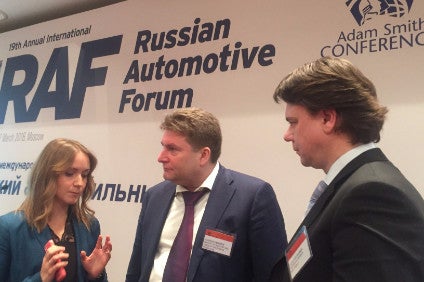
Russia’s Deputy Industry Minister has launched a robust defence of Moscow’s response to the current automotive industry crisis, noting its support programme coupled with a falling ruble should lead to improved export opportunities.
Some have forecast the Russian market to dive to 1.2m this year, but that prediction is very much at the lower end, with The Kremlin conceding it would like to at least stabilise numbers to 1.6m during 2016, following more than a year of plunging sales which saw numbers collapse 36%.

Discover B2B Marketing That Performs
Combine business intelligence and editorial excellence to reach engaged professionals across 36 leading media platforms.
Deputy Industry and Trade Minister, Alexander Morozov told just-auto on the sidelines of last week’s Russian Automotive Forum (RAF) organised by Adam Smith Conferences in Moscow, the government’s automotive support plan was the first in Prime Minister, Dmitry Medvedev’s in-tray to be signed, with the sector remaining a priority for support.
“The forecast [s] for 2015 were even more pessimistic than we actually got – we managed to avoid this catastrophic scenario,” said Morozov. “We managed to launch a number of programmes to support the OEMs in the market and improve the market.
“The government spent budget money to support manufacturing, make [it] more efficient than 2009. The government, having spent RUB43bn (US$633m), has managed the market at better levels. We think it necessary to maintain the passenger and truck market and not let it drop further.
“This year we plan to increase the support of State funding [to RUB50bn], first renewing the car fleet, then leasing programmes and special automotive lending for trucks and supporting interest rate subsidies to buy electric transportation for cities, as well as [renewing] the ambulance fleet.”
Morozov added the increased spending plans would now be submitted for final approval, but given the parlous state of the auto sector and despite the equally precarious nature of The Kremlin’s finances with the extremely low oil price and falling rouble, this looks likely to be rubber stamped.
However, the Deputy Industry Minister cautioned these grants would not be open-ended, noting: “Naturally we will have to trim this strategy [at some point] – that is what the President said and by Q3 I hope we will have developed the new strategy [for the] macro-economic development of the industry.”
Morozov also highlighted a theme running throughout the RAF in Moscow, namely that of localisation.
A ruble previously in freefall, if somewhat now stabilised, is making domestic Russian component manufacturers extremely competitive, also allowing the possibility of expanding the current low level of exports.
“Our goal is not to allow [a] reduction of the market, not below 1.6m cars and to create conditions for export opportunities by 2025,” added the Deputy Minister. “[In] 2015, share of exports was 7.7%, we are not happy with this and the State…in 2016 is planning to support our export potential within the framework of the economic instruments available and the constraints we have.
“In spite of the challenging market situation, our cars are becoming more safe and more clean. From 1 January, all cars manufactured after 2018 will be mandatorily equipped with Glonass [emergency communication system] and our automotive industry is moving towards the introduction of these systems of security and safety.”
Glonass navigation information infrastructure is built to serve all Russian roads and vehicles equipped with such GPS communication terminals at the factory or a certified service centre. They will be able, after an accident, to collect data on its location, time and severity, as well as transmit it with a high-priority alert to a Glonass operator.
Once verified, this information is passed on to the emergency response services – the 1-1-2 system or duty police stations.
Vehicle drivers can also contact a Glonass operator manually by pressing a button.






